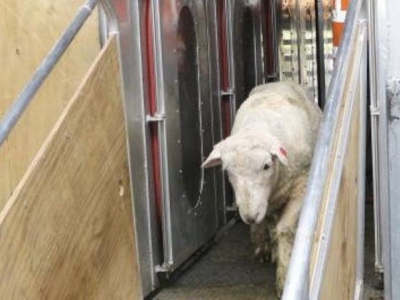Sheep farmers now able to breed low-methane animals

In a world first, New Zealand sheep farmers now can breed animals that emit less methane.
Beef + Lamb New Zealand (B+LNZ) Genetics has launched a “methane research breeding value,” which could be used to help select important traits that ram breeders want to bolster within their flocks, e.g., low-methane-producing animals.
According to the B+LNZ announcement, the launch of this breeding tool is due to a 10-year, multimillion-dollar collaboration among the Pastoral Greenhouse Gas Research Consortium (PGGRC), New Zealand Agricultural Greenhouse Gas Research Center (NZAGRC) and AgResearch, supported by New Zealand's Ministry of Business, Innovation & Employment and Ministry for Primary Industries.
Ram breeders wanting to pursue the methane breeding value will need to measure a portion of their flock using portable accumulation chambers, B+LNZ said. These chambers are on board an AgResearch-operated trailer that travels to individual farms. Sheep spend 50 minutes in the chambers, where their gas emissions are measured; this is done twice, at a 14-day interval. The resulting information is then used alongside other genetic information to calculate the methane breeding value, B+LNZ said.
“I’ve undertaken the methane breeding value measurements because I believe an animal that is healthy and doing well should produce less methane, and I wanted to test that,” said New Zealand sheep breeder Russell Proffit, whose Raupuha Stud began breeding for lower-input sheep 20 years ago. "I don’t know if that’s the case yet, but either way, breeding for less methane complements what we are working to achieve on our stud -- that is, more robust rams that require less inputs and make less demand on the environment."
Proffit said his commercial farmer clients have already expressed interest in the methane breeding value. “Farmers are more interested than I anticipated. They are thinking about this issue and looking for ways to make progress,” he said.
B+LNZ chief executive Sam McIvor added that this interest was reinforced in recent B+LNZ research of 1,000 farmers, where tools and information to reduce greenhouse gas emissions were among farmers’ top five on-farm priorities.
PGGRC general manager Mark Aspin said the new breeding value takes advantage of the fact that individual sheep vary in their levels of methane emissions, and these differences are passed on to the next generation.
“This is a global first for any species of livestock. Launching the methane breeding value gives New Zealand’s sheep sector a practical tool to help lower our agricultural greenhouse gases. This is significant," Aspin said. "Up until now, the only option available to farmers wanting to lower their greenhouse gas emissions has been to constantly improve their overall farming efficiency.
“This takes us a step further — towards actually lowering sheep methane emissions, in keeping with the sector’s commitment to work towards reducing its greenhouse emissions,” he added.
Although progress via breeding can be slow — around 1% per year, assuming that a breeder selects only for methane — it is cumulative and has no negative impact on productivity, B+LNZ said.
Aspin said it is important to note that the biggest influence on methane emissions is the amount of feed an animal eats.
“To that end, the consortium is working on three other technologies with a focus on reducing the amount of methane generated by feed. So, by breeding sheep that produce less methane per mouthful eaten — as other methane-reducing technologies come on stream — the influence of these sheep on the national flock’s methane production becomes compounding,” Aspin said.
PGGRC was established 16 years ago to provide the knowledge and tools New Zealand farmers would need to mitigate greenhouse gas emissions. It is funded by eight New Zealand agricultural sector partners via a 50/50 partnership with the New Zealand Ministry of Business Innovation & Employment and works in collaboration with the New Zealand government through the NZAGRC.
Related news
 New in vitro tool estimates ruminal protein degradability
New in vitro tool estimates ruminal protein degradability Meeting protein requirements and improving nitrogen efficiency in cows under different physiological conditions can be more precise using new tool for diet
 Five tips for making high-quality flaked corn for cattle
Five tips for making high-quality flaked corn for cattle Maximizing the surface area of grain to rumen microbes is a critical first step in optimizing performance in cattle.
 Brazil: Low feed prices could expand feedlot cattle production
Brazil: Low feed prices could expand feedlot cattle production Increasing global and domestic demand is expected to boost Brazil’s production of pork and beef, while low and stable feed prices may support the growth of feed